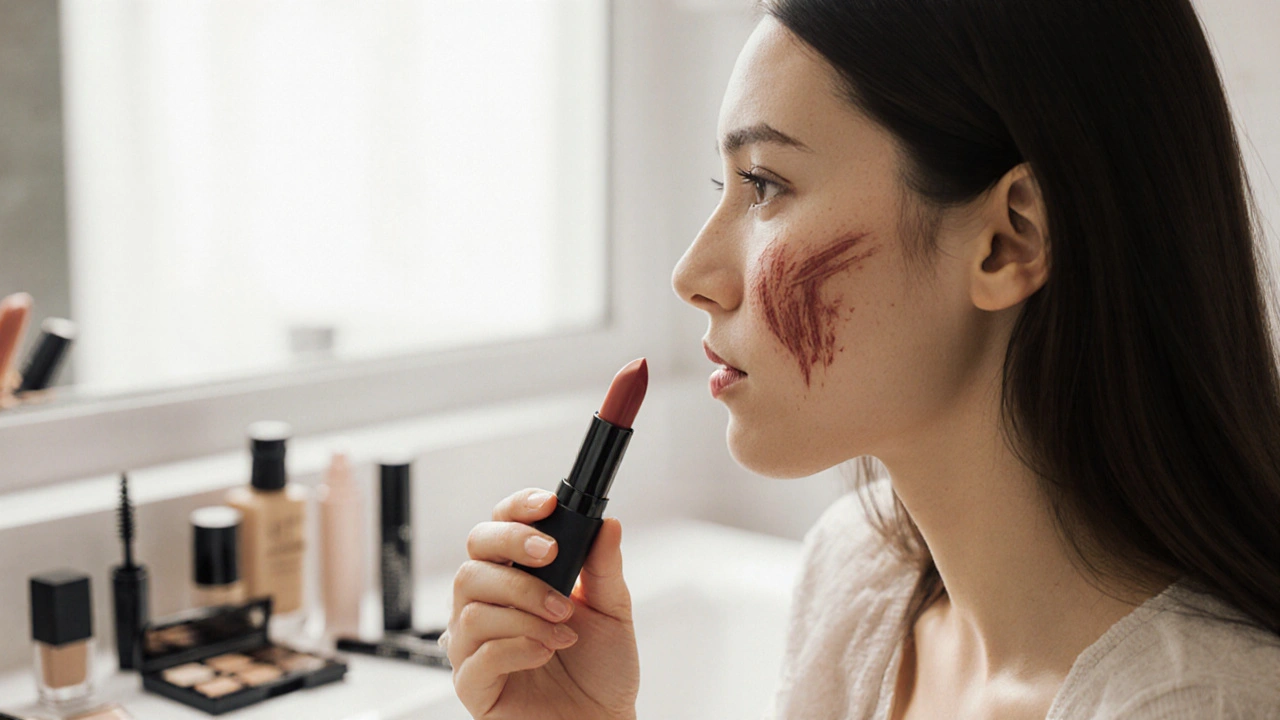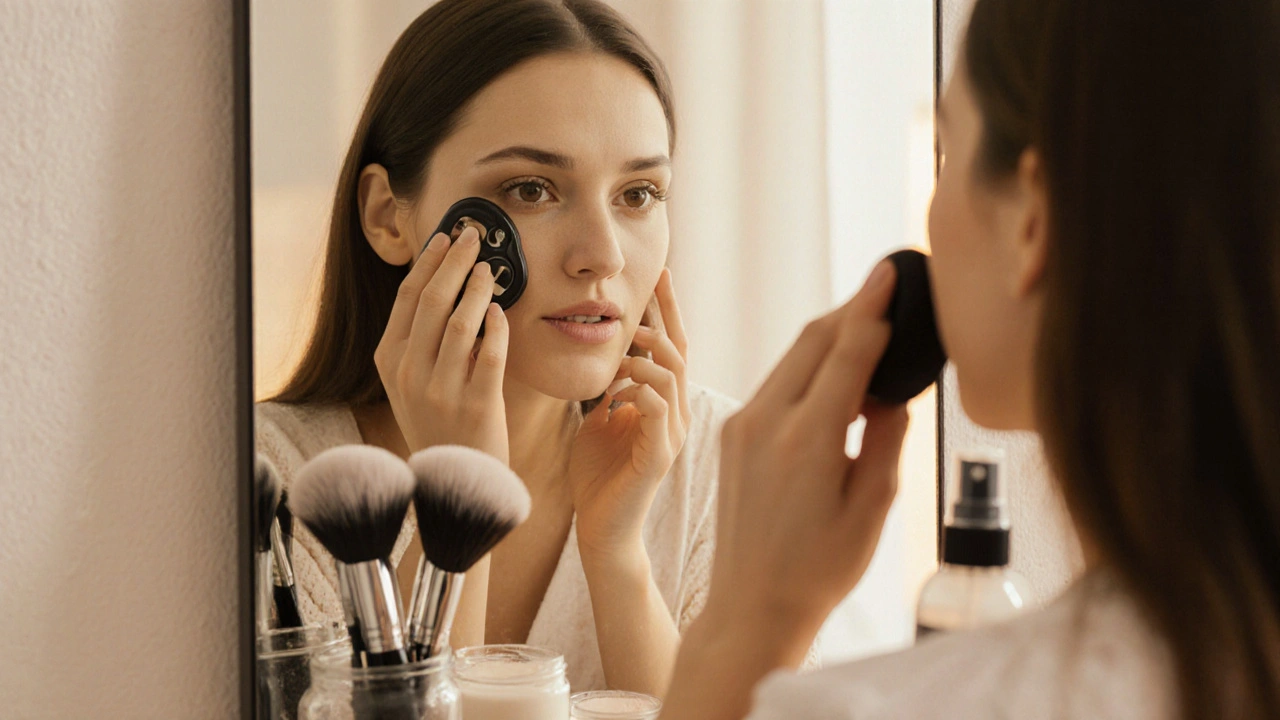
Safe Cosmetics Ingredient Checker for Dermatitis
Enter one or more ingredients separated by commas to check if they're safe for dermatitis-prone skin.
Did you know that up to 30% of people with dermatitis report a reaction after using ordinary lipstick or foundation? That’s a staggering number, and it shows why the right cosmetics matter as much as a good moisturizer. Below you’ll find a step‑by‑step plan that lets you enjoy makeup without sparking a flare‑up.
Understanding Dermatitis and Its Relationship with Cosmetics
Dermatitis is a chronic skin condition that creates red, itchy, and inflamed patches. The skin barrier is already compromised, so anything that rubs, smells, or contains harsh chemicals can tip the balance into an acute reaction. When you apply a product that your skin can’t tolerate, you’re essentially adding a new irritant to an already stressed surface.
What Cosmetic Ingredients Typically Trigger Flare‑Ups?
Not every ingredient is a villain, but a handful show up repeatedly in irritation reports:
- Fragrance - both natural essential oils and synthetic perfume blends can act like a chemical irritant.
- Alcohol (especially denatured alcohol) - dries out the skin and weakens the barrier.
- Preservatives such as parabens, formaldehyde releasers, and methylisothiazolinone.
- Lanolin and other animal‑derived fats - beautiful for dry skin but often allergenic.
- Heavy pigments and dyes - can contain metal salts that irritate sensitive skin.
When you spot any of these on a label, it’s a red flag for dermatitis‑prone users.
Reading Labels Like a Pro
The best way to avoid trouble is to become fluent in ingredient lists. Look for the following cues:
- Ingredients listed in descending order of concentration - the first five are the most dominant.
- Terms like “fragrance‑free”, “unscented”, or “hypoallergenic” - these are marketing claims, so still double‑check the actual list.
- Identify safe bases: mineral pigments (titanium dioxide, zinc oxide), silicone oils (dimethicone), and plant‑derived humectants (glycerin, hyaluronic acid) are generally well‑tolerated.
Here’s a quick cheat‑sheet to keep by your vanity:
- ✅ Safe: Zinc oxide, titanium dioxide, dimethicone, glycerin, squalane.
- ⚠️ Avoid: Fragrance, alcohol denat., parabens, methylisothiazolinone, lanolin.
Safe Makeup Categories for Sensitive Skin
Not all makeup is created equal. Three categories stand out for dermatitis sufferers:
- Mineral makeup uses raw mineral pigments like zinc oxide and titanium dioxide, offering a non‑reactive base. It’s usually free of added fragrance and preservatives.
- Silicone‑based cosmetics rely on dimethicone and related siloxanes, which create a breathable barrier that locks in moisture. They’re great for “no‑feel” foundations.
- Fragrance‑free/hypoallergenic lines are formulated without known allergens and often undergo dermatologic testing. While not a guarantee, they’re a solid starting point.
Top Recommended Brands (2025)
| Brand | Key Product Type | Safe Ingredients Highlight | Price Range (AU$) | Triggers Avoided |
|---|---|---|---|---|
| bareMinerals | Loose & pressed foundation | Zinc oxide, titanium dioxide, jojoba oil | 30‑70 | Fragrance, parabens, alcohol |
| Clinique Redness Solutions | Liquid concealer & BB cream | Dimethicone, niacinamide, shea butter | 35‑65 | Fragrance, lanolin, formaldehyde releasers |
| Almay Sensitive Skin | Foundation, mascara, eye shadow | Glycerin, squalane, mineral pigments | 20‑45 | Fragrance, dyes, high‑alcohol solvents |
| Neutrogena Skin‑Safe | Tinted moisturizer & powder | Zinc oxide, dimethicone, hyaluronic acid | 25‑55 | Parabens, fragrance, methylisothiazolinone |
These brands consistently pass dermatologist patch‑test panels and keep the irritation‑causing list short. Prices vary, but you can usually find a starter kit for under $70.
Patch Testing: Your First Line of Defense
Even a “hypoallergenic” label can’t guarantee a 100% match with your unique skin chemistry. Follow this simple patch‑test routine before you invest in a new product:
- Choose a small, hidden area - behind the ear or on the inner forearm.
- Apply a pea‑sized amount of the product and let it sit for 24hours.
- Watch for redness, itching, or swelling. No reaction? You’re likely safe to use on the face.
Make a habit of patch testing every new foundation, powder, or lipstick you pick up.

Pre‑Makeup Skin Prep to Strengthen the Barrier
Think of your skin barrier as the wall that keeps irritants out. Reinforce it with these steps before you even open the makeup bag:
- Barrier cream a thick, occlusive moisturizer that locks in moisture and reduces transepidermal water loss - apply a pea‑size amount and let it absorb for 10 minutes.
- Use a gentle, sulfate‑free cleanser that maintains the skin’s natural pH (around 5.5).
- Finish with a serum containing ceramides or niacinamide to rebuild lipid layers.
When the barrier is healthy, you’ll notice less sting from even the safest makeup.
Application Tips That Keep Irritation at Bay
Even safe products can cause trouble if you apply them aggressively. Here’s a low‑stress routine:
- Clean brushes - dirty tools harbor bacteria that can inflame dermatitis.
- Start with a light layer of foundation using a damp beauty sponge; avoid rubbing motions.
- Build coverage only where needed - spot‑conceal with a silicone‑based concealer.
- Set with a loose mineral powder applied with a fluffy brush; pat instead of sweeping.
- Seal the look with a non‑alcoholic setting spray to lock moisture without drying the skin.
Give each layer a minute or two to settle before adding the next. This reduces friction and lets the skin breathe.
Quick Reference Checklist
- ✅ Read the ingredient list - avoid fragrance, alcohol denat., parabens, lanolin.
- ✅ Choose mineral, silicone‑based, or certified hypoallergenic formulas.
- ✅ Patch test every new product for 24hours.
- ✅ Prep skin with a barrier‑boosting moisturizer.
- ✅ Use clean tools and apply in thin layers.
- ✅ Keep a symptom diary to spot patterns.
Keep this cheat‑sheet on your bathroom mirror; a quick glance can save you days of flare‑up.
Frequently Asked Questions
Can I wear liquid lipstick if I have dermatitis?
Yes, as long as the formula is fragrance‑free, dye‑free, and you’ve done a patch test. Look for brands that list “hypoallergenic” and avoid talc or lanolin.
Is mineral makeup really non‑irritating?
Mineral makeup primarily uses zinc oxide and titanium dioxide, which sit on the skin’s surface without penetrating. They’re generally safe for dermatitis, but still check for added fragrance or binders.
How often should I replace my makeup brushes?
Aim for every 3‑4weeks if you use them daily. Deep‑clean them with a gentle soap and let them air‑dry fully before the next use.
Do silicone‑based foundations cause breakouts?
Silicones like dimethicone are inert and non‑comedogenic, so they rarely cause acne or dermatitis. They actually help lock in moisture, which is a plus for flaky skin.
What should I do if I still get a reaction after using a "safe" product?
Stop using the product immediately, rinse the area with lukewarm water, and apply a soothing barrier cream. If the redness persists beyond a few hours, consult a dermatologist for a targeted treatment.


Comments
Jacob Smith
Yo, this guide is a game‑changer-grab those mineral bases and ditch the fragrance, you got this!
Chris Atchot
Hey there, great post, very thorough, I especially appreciate the clear breakdown of safe vs. irritant ingredients, keep up the good work!
Shanmugapriya Viswanathan
Honestly, this is exactly what Indian skin‑care lovers need 😎, many western brands ignore our sensitivities, so kudos for the solid list!
Rhonda Ackley
Reading through this guide felt like embarking on an epic odyssey through the labyrinth of cosmetics, each paragraph unfurled like a scroll revealing ancient secrets hidden beneath layers of marketing spin. The opening statistics about lipstick flare‑ups set a dramatic tone, instantly grabbing attention. As I moved into the section on dermatitis basics, the description of the compromised skin barrier painted a vivid picture of a fragile fortress under siege. The enumeration of notorious irritants-fragrance, alcohol, parabens-read like a villains roster, each name evoking a shiver. When you transitioned to label‑reading tips, the advice was crisp, turning the daunting ingredient list into a manageable treasure map. I loved the cheat‑sheet; the ✅ and ⚠️ icons are like signposts on a treacherous road. The deep dive into mineral, silicone‑based, and hypoallergenic categories felt like a tour of safe havens. Your brand recommendations for 2025 were spot‑on, especially the inclusion of price ranges, which grounds the advice in reality. The patch‑test ritual is a lifesaver, turning experimentation into a disciplined science. Your pre‑makeup skin prep routine reads like a ritualistic rite, bestowing the barrier with armor before any product dares to touch it. The application tips are Goldilocks‑perfect: not too harsh, not too lax, just right for sensitive souls. The quick reference checklist serves as an at‑a‑glance guardian angel for daily decisions. The FAQ section anticipates doubts before they even form, a true mark of foresight. Overall, the guide balances clinical rigor with approachable prose, making it both a textbook and a friendly chat over coffee. Thank you for this masterpiece; it will undoubtedly keep countless flare‑ups at bay.
Sönke Peters
Solid advice, especially the barrier‑cream tip-simple but effective.
Paul Koumah
Wow, Rhonda you really over‑explained everything-nice job.
Erica Dello
Really, that was way too long 😐.
sara vargas martinez
The guide does a commendable job of merging scientific insight with practical steps, yet it could benefit from a deeper exploration of the molecular interactions between silicones and the stratum corneum. For instance, dimethicone’s occlusive properties not only prevent moisture loss but also form a semi‑permeable membrane that can modulate transepidermal water flux. Additionally, while the list of safe ingredients is robust, a brief discussion on the potential cumulative effect of multiple low‑level irritants would enhance the reader’s risk assessment capabilities. Overall, the content is reliable, but a few more mechanistic details would elevate it from good to exceptional.
Todd Anderson
While Ms. Vargas offers valuable observations, the omission of a rigorous discussion on the physicochemical stability of silicone polymers in aqueous media constitutes a notable lacuna. A scholarly treatise should, in my estimation, address such considerations to fortify its academic stature.
Dexter Smith
Interesting points, especially the emphasis on cumulative irritants; data-driven approaches will help refine these guidelines.